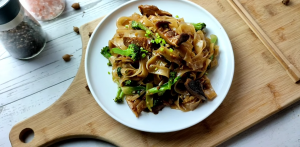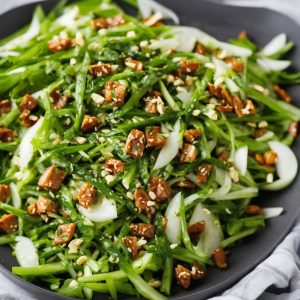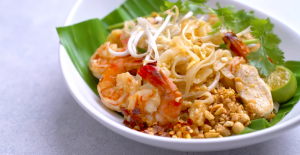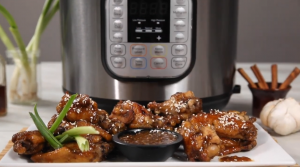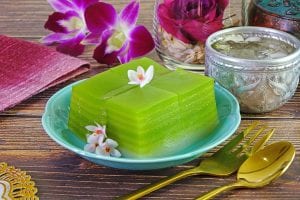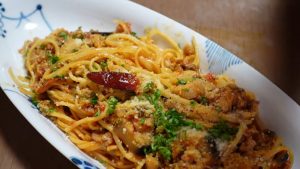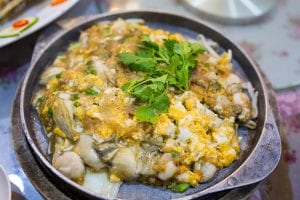Embrace the vibrant flavors of Thailand with this authentic vegetarian pad Thai recipe. Featuring tofu, crisp vegetables, and tangy tamarind sauce, this dish brings a symphony of textures and tastes to your dinner table.
While most of the ingredients for this recipe are quite common, there are a couple that you might need to hunt for. Tamarind paste, a tangy concentrate made from the fruit of the tamarind tree, is a key ingredient in pad Thai and may not be in your pantry. Look for it in the Asian foods section of your supermarket. The other ingredient to note is rice noodles; these are usually found in the same aisle.
Ingredients for Vegetarian Pad Thai with Tofu
Rice noodles: These are a staple in Asian cuisine and are made from rice flour and water. They have a neutral taste and absorb the flavors of the dish they're in.
Salt: Used to enhance the flavor of the dish.
Rice vinegar: Adds a mild, slightly sweet tang to the dish.
Tamarind paste: Gives the pad Thai its signature tangy, sour taste.
Granulated sugar: Balances the sourness of the tamarind.
Paprika: Adds a mild sweet-peppery flavor.
Canola oil: Used for sauteing and has a light flavor that doesn't overpower the dish.
Tofu: A good source of protein for vegetarians and adds a unique texture.
Eggs: Adds protein and richness to the dish.
Unsalted peanuts: Gives a nice crunch and nutty flavor.
Bean sprouts: Adds a fresh, crunchy texture.
Lime: Provides a fresh citrus flavor that brightens up the dish.
Cilantro: Gives a fresh, herbaceous flavor.
Red pepper flakes: Adds heat to the dish, adjust according to your preference.
One reader, Briny Cornell says:





This vegetarian pad thai with tofu recipe is a game-changer! The flavors are perfectly balanced, and the tofu adds a delightful texture. It's a hit with my family, and we love how easy it is to make. I highly recommend trying it out for a delicious and satisfying meal.
Techniques for Crafting Vegetarian Pad Thai with Tofu
How to soak the noodles: Soak the rice noodles in cold water for at least 2 hours or up to 24 hours in a large container. It can be refrigerated or not.
How to make the sauce: Whisk together salt, rice vinegar, tamarind concentrate, and sugar until smooth in a shallow bowl. Adjust the sauce as needed and add a pinch of paprika or cayenne powder for color.
How to cook the tofu: Heat a wok or large pan with high sides over high heat. Add oil and cook the tofu until it gets some color, about 2 to 3 minutes on each side. Remove the tofu and set it aside.
How to cook the eggs: Crack the eggs into the pan and gently loosen the yolk with the tip of a wooden spoon. Cook for about 1 minute, then push the eggs to the side of the pan and add the tofu back.
How to soften the noodles: Transfer a portion of the soaked noodles to a fine-mesh sieve and dip them in and out of hot water to soften them. Shake out the excess hot water and transfer the noodles to the pan.
How to finish the pad thai: Toss the noodles with the sauce, peanuts, and bean sprouts in the pan. Cook for 2 to 3 minutes until everything is heated through. Serve immediately with garnishes.
How To Make Vegetarian Pad Thai with Tofu
Rice noodles are tossed with seared tofu, bean sprouts, and eggs for this delicious vegetarian pad thai. Cook this dish in less than 30 minutes!
Serves:
Ingredients
For Pad Thai:
- 14ozrice noodles,(1 package), flat, wide
- 3tspsalt
- ¾cuprice vinegar
- 2tsptamarind paste,or concentrate
- 1cupgranulated sugar
- pinchpaprika,or cayenne powder
- 12tbspcanola oil,or vegetable, divided
- 1lbtofu,extra firm, drained, cubed
- 4large eggs
- ⅓cupunsalted peanuts,roasted, chopped roughly
- 1cupbean sprouts
For Garnish (Optional):
- 1lime,cut into quarters
- 2tbspunsalted peanuts,roasted, chopped roughly
- cilantro,chopped, for garnish
- red pepper flakes,for garnish
Instructions
Prep the Noodles:
-
In a large container, preferably one with a lid, soak the noodles in cold water, enough to cover so that no noodle is poking out.
-
Soak for at least 2 hours or up to 24 hours. It can be refrigerated or not.
Sauce:
-
In a shallow bowl, whisk together 2 teaspoons of salt, vinegar, tamarind concentrate, and sugar until smooth.
-
Taste. Adjust the sauce as needed. Add more salt depending on the other ingredients. Add a pinch of paprika or cayenne powder for color.*
-
Bring a large pot of water to boil.
-
Divide all of the ingredients into 2 batches. Arrange them near the stove and prepare each batch completely, one after the next.
Tofu:
-
Heat a wok or other large pan with high sides over high heat maintained throughout cooking the pad Thai. Add 2 tablespoons of oil. When it starts to shimmer a bit, it’s ready.
-
Add the tofu for the first batch to the pan and let it get some color on it for about 2 to 3 minutes. Toss it frequently once there’s browning on one side.
-
Cook for another 2 to 3 minutes, and then remove the tofu to a plate. Set aside.
Eggs:
-
Add 2 to 3 tablespoons of oil to the pan. When the oil starts to shimmer a bit, it’s ready.
-
Crack the eggs for this batch into the pan and, using the tip of a wooden spoon, gently loosen the yolk. There should be enough oil in the pan so it looks as though the egg is floating, or suspended, in the oil.
-
Gently shake and flip the egg around in the pan. Break it up a bit with the spoon for about 1 minute, but don’t scramble it.
-
Push the eggs off to the side of the pan to make room for the tofu. Add the tofu back to the pan.
Noodles:
-
Take several handfuls of the noodles, about half the total amount, out of the water they’re soaking in and transfer to a fine-mesh sieve.
-
Hold the sieve over the pot of hot water and gently dip the noodles up and down, in and out of the water, to soften them but not cook them.
-
Shake out the excess hot water and taste to make sure the noodles have softened but still have a little give.
-
Transfer the noodles to the hot pan. Toss them gently in the pan and stir them briefly to keep them from sticking together.
-
When the noodles look shiny, add about ¼ cup of the sauce to the pan and gently toss and flip the noodles in the pan. Stir them quickly for 1 to 2 minutes to integrate and absorb the sauce.
-
Add the peanuts and the sprouts, and toss all ingredients together quickly. Cook for 2 to 3 minutes all together until everything is heated through.
-
Turn the heat off the pan and add seasonings to taste. Repeat for making the second batch of pad Thai.
-
Serve immediately in individual bowls with wedges of lime, along with additional peanuts, chopped cilantro, and chili flakes. Enjoy!
Recipe Notes
*Only ½ cup of sauce is needed for this recipe (¼ cup per batch). Any extra sauce can be stored in the fridge for up to 3 months or used on leftovers.
Nutrition
- Calories: 1196.60kcal
- Fat: 60.39g
- Saturated Fat: 6.86g
- Trans Fat: 0.18g
- Monounsaturated Fat: 34.08g
- Polyunsaturated Fat: 17.59g
- Carbohydrates: 138.80g
- Fiber: 5.16g
- Sugar: 53.57g
- Protein: 26.83g
- Cholesterol: 186.00mg
- Sodium: 1080.47mg
- Calcium: 305.80mg
- Potassium: 474.47mg
- Iron: 4.66mg
- Vitamin A: 96.27µg
- Vitamin C: 9.83mg
Mastering the Art of Tofu in Pad Thai
When preparing your tofu, it's important to press it before cooking to remove excess moisture. This will help it to absorb the flavors of the sauce more effectively and also achieve a better texture when fried. To do this, wrap the tofu in a clean kitchen towel or paper towels, place it on a flat surface, and put a heavy object on top, such as a cast iron skillet or a cutting board with a few cans on top. Let it sit for at least 15-30 minutes before cooking. This simple step can significantly enhance the taste and texture of your vegetarian pad thai.
Time-Saving Tips for Vegetarian Pad Thai
Prep ahead: Soak the rice noodles in advance to cut down on prep time when you're ready to cook.
Organize ingredients: Measure and prepare all ingredients before starting to cook for a smoother cooking process.
Quick cook: Cook the tofu and eggs simultaneously in separate pans to speed up the cooking process.
Efficient multitasking: While the noodles are soaking, use that time to prepare the sauce and chop the garnishes to save time later.
Streamline cleanup: Clean as you go to minimize the post-cooking cleanup time.
Tofu prep: Press the tofu in advance to remove excess moisture, making it quicker to brown in the pan.
Consolidate steps: Combine similar tasks, such as soaking the noodles while preparing the sauce, to save time and effort.
Substitute Ingredients For Vegetarian Pad Thai with Tofu Recipe
rice noodles - Substitute with zucchini noodles: Zucchini noodles can be used as a low-carb and lighter alternative to rice noodles, adding a fresh and crunchy texture to the dish.
tofu - Substitute with tempeh: Tempeh is a firmer and nuttier alternative to tofu, providing a heartier texture and a rich, earthy flavor to the dish.
eggs - Substitute with scrambled silken tofu: Scrambled silken tofu can mimic the texture and appearance of scrambled eggs, making it a suitable vegan alternative in the recipe.
unsalted peanuts - Substitute with cashews: Cashews can provide a creamy and buttery flavor, adding a delicious richness to the dish.
bean sprouts - Substitute with shredded cabbage: Shredded cabbage can offer a similar crunchy texture and mild flavor, complementing the other ingredients in the dish.
rice vinegar - Substitute with white wine vinegar: White wine vinegar can provide a slightly milder acidity and a delicate flavor, serving as a suitable substitute for rice vinegar in the recipe.
tamarind paste - Substitute with lime juice and brown sugar: A mixture of lime juice and brown sugar can replicate the sweet and tangy flavor of tamarind paste, adding a refreshing citrusy note to the dish.
granulated sugar - Substitute with coconut sugar: Coconut sugar can be used as a natural and less refined alternative to granulated sugar, imparting a subtle caramel-like sweetness to the dish.
canola oil - Substitute with sesame oil: Sesame oil can add a distinct nutty flavor and aroma, enhancing the overall taste of the dish.
unsalted peanuts (for garnish) - Substitute with sesame seeds: Sesame seeds can provide a similar crunchy texture and a nutty flavor, serving as a delightful garnish for the dish.
Presenting Vegetarian Pad Thai with Tofu
Elevate the plating: When presenting the vegetarian pad thai, focus on creating a visually stunning plate. Use fresh herbs and edible flowers to add vibrant colors and a touch of elegance to the dish.
Incorporate height and layers: Arrange the pad thai and tofu in a way that creates visual interest. Consider using bamboo skewers to stack the tofu or noodles, adding dimension to the presentation.
Utilize negative space: Embrace the beauty of simplicity by allowing some areas of the plate to remain empty. This will draw attention to the vibrant colors and textures of the pad thai and tofu.
Garnish with precision: Pay attention to the placement of the garnishes. Sprinkle crushed peanuts and red pepper flakes with precision, ensuring that each element enhances the overall presentation.
Incorporate a touch of citrus: Introduce a pop of brightness by adding a lime wedge to the plate. The citrus not only complements the flavors but also adds a visually appealing element to the presentation.
Consider the plate shape and color: Select a plate that complements the colors of the dish. A round, white plate can provide a clean canvas for the vibrant pad thai, allowing the colors to stand out.
Balance and symmetry: Aim for a balanced presentation by arranging the components in a symmetrical manner. This creates a sense of harmony and sophistication on the plate.
Attention to detail: Pay attention to the finer details, such as wiping the edges of the plate to ensure a clean presentation and using tweezers to delicately place the garnishes with precision.
Essential Tools for Making Pad Thai
- Large container: A large container is needed to soak the rice noodles in cold water.
- Shallow bowl: A shallow bowl is used to whisk together the ingredients for the pad thai sauce.
- Large pot: A large pot is required to boil the water for cooking the noodles.
- Wok or large pan with high sides: A wok or a large pan with high sides is used to cook the tofu, eggs, and noodles for the pad thai.
- Fine-mesh sieve: A fine-mesh sieve is used to transfer the soaked noodles and to drain excess water before cooking.
- Wooden spoon: A wooden spoon is used to gently loosen the egg yolk and to stir the ingredients while cooking.
Storing and Freezing Vegetarian Pad Thai
Here are the storing and freezing guidelines for vegetarian pad thai with tofu:
- Let the pad thai cool completely to room temperature before storing. This will prevent condensation from forming and making the noodles soggy.
- Store leftover pad thai in an airtight container in the refrigerator for up to 3-4 days. Glass containers with tight-fitting lids work best to keep the flavors fresh and prevent the dish from absorbing any odors from the fridge.
- If you want to freeze the pad thai, transfer it to a freezer-safe container or resealable plastic bag. Remove as much air as possible from the bag to prevent freezer burn. Label the container or bag with the date and contents.
- Frozen pad thai can be stored for up to 2-3 months in the freezer. However, keep in mind that the texture of the noodles may change slightly after being frozen and thawed.
- To reheat refrigerated pad thai, warm it up in a skillet or wok over medium heat until heated through. You can add a splash of water or vegetable broth to help loosen up the noodles and prevent them from drying out.
- For frozen pad thai, thaw it in the refrigerator overnight before reheating. Once thawed, reheat it in a skillet or wok over medium heat, stirring frequently, until heated through. You may need to add a bit more sauce or seasonings to refresh the flavors.
- If you have leftover lime wedges, peanuts, or bean sprouts, store them separately in the refrigerator and add them as toppings when serving the reheated pad thai for optimal freshness and texture.
How To Reheat Pad Thai Leftovers
- The best way to reheat leftover vegetarian pad thai with tofu is to use a wok or a large skillet over medium-high heat. Add a small amount of oil to the pan and let it heat up before adding the leftover pad thai.
- Gently toss the noodles and other ingredients in the hot pan, stirring frequently to ensure even heating and to prevent the noodles from sticking together. If the noodles seem dry, you can add a splash of water or vegetable broth to help rehydrate them and create some steam.
- Continue stirring and tossing the pad thai until it is heated through and the noodles are soft and pliable, which should take about 3-5 minutes. Be careful not to overcook the noodles, as they can become mushy and lose their texture.
- If you prefer a crispier texture for your tofu, you can remove the noodles from the pan once they are heated through and set them aside. Then, add a bit more oil to the pan and stir-fry the tofu separately until it is crispy and golden brown before adding the noodles back to the pan and tossing everything together.
- Another option for reheating leftover pad thai is to use a microwave. Place the desired portion of pad thai in a microwave-safe dish and cover it with a damp paper towel. Microwave on high for 1-2 minutes, stirring halfway through, until the noodles are heated through and soft. Be careful not to overheat the noodles, as they can become rubbery in the microwave.
- Regardless of the reheating method you choose, be sure to taste the pad thai and adjust the seasonings as needed before serving. You may want to add a squeeze of lime juice, a sprinkle of chopped peanuts, or some fresh cilantro to brighten up the flavors and add some freshness to the dish.
Fascinating Facts About Pad Thai
Tofu is a great source of protein and contains all nine essential amino acids. It is also a good source of iron and calcium, making it a nutritious addition to a vegetarian diet.
Is Making Vegetarian Pad Thai at Home Cost-Effective?
The cost-effectiveness of this vegetarian pad thai with tofu recipe is quite high. The main ingredients, such as rice noodles, tofu, eggs, and peanuts, are generally affordable and readily available. The use of bean sprouts and basic seasonings further contributes to its budget-friendly nature. With careful planning, this dish can be prepared economically, making it suitable for a household. In terms of a rating, this recipe earns a solid 8 out of 10 for its balance of cost, flavor, and nutritional value. The approximate cost for a household of four people is around $15-$20, making it a reasonable and satisfying meal option.
Is Vegetarian Pad Thai with Tofu Healthy?
This vegetarian pad thai recipe, while delicious, has some aspects that could be improved to make it healthier:
- The recipe uses a significant amount of sugar (1 cup) in the sauce, which adds unnecessary calories and carbohydrates.
- Canola oil is used for cooking, which is a refined oil high in omega-6 fatty acids. Excessive consumption of omega-6 can contribute to inflammation in the body.
- The recipe lacks a variety of vegetables, which could provide additional nutrients and fiber.
However, there are some positive aspects:
- The use of tofu provides a good source of plant-based protein.
- The inclusion of bean sprouts adds some freshness and crunch to the dish.
- The garnishes of lime, cilantro, and peanuts offer additional flavor and nutrients.
To make this recipe healthier, consider the following suggestions:
- Reduce the amount of sugar in the sauce by half or more, and replace it with a natural sweetener like honey or coconut sugar.
- Use a healthier cooking oil, such as coconut oil or avocado oil, which are more stable at high temperatures and have a better fatty acid profile.
- Increase the variety of vegetables in the dish. Add carrots, bell peppers, and bok choy to boost the nutrient content and provide more texture and color.
- Use whole grain or brown rice noodles instead of white rice noodles to increase the fiber content.
- Opt for low-sodium soy sauce or tamari to reduce the overall sodium content of the dish.
Editor's Take on This Vegetarian Pad Thai Recipe
The recipe for vegetarian pad thai with tofu is a delightful and flavorful dish. The use of tamarind paste and rice vinegar in the sauce adds a tangy and sweet balance, while the addition of peanuts and bean sprouts provides a satisfying crunch. The method of cooking the tofu and eggs separately ensures that each ingredient retains its unique texture and flavor. Overall, this recipe offers a wonderful combination of savory, sweet, and tangy flavors, making it a delightful vegetarian option for any occasion.
Enhance Your Vegetarian Pad Thai with Tofu Recipe with These Unique Side Dishes:
Tasty Alternatives to Vegetarian Pad Thai with Tofu
Perfect Appetizers and Desserts for a Vegetarian Pad Thai Feast
Why trust this Vegetarian Pad Thai with Tofu Recipe:
This vegetarian pad thai with tofu recipe offers a delightful fusion of flavors and textures, making it a must-try for any vegetarian or tofu enthusiast. The carefully curated combination of rice vinegar, tamarind paste, and unsalted peanuts creates a harmonious balance that elevates the dish. The step-by-step instructions ensure a seamless cooking experience, while the use of rice noodles guarantees an authentic and satisfying meal. Trust in this recipe to deliver a flavorful and nourishing dining experience that will leave a lasting impression.
Was this page helpful?
Have your own special recipe to share? Submit Your Recipe Today!




